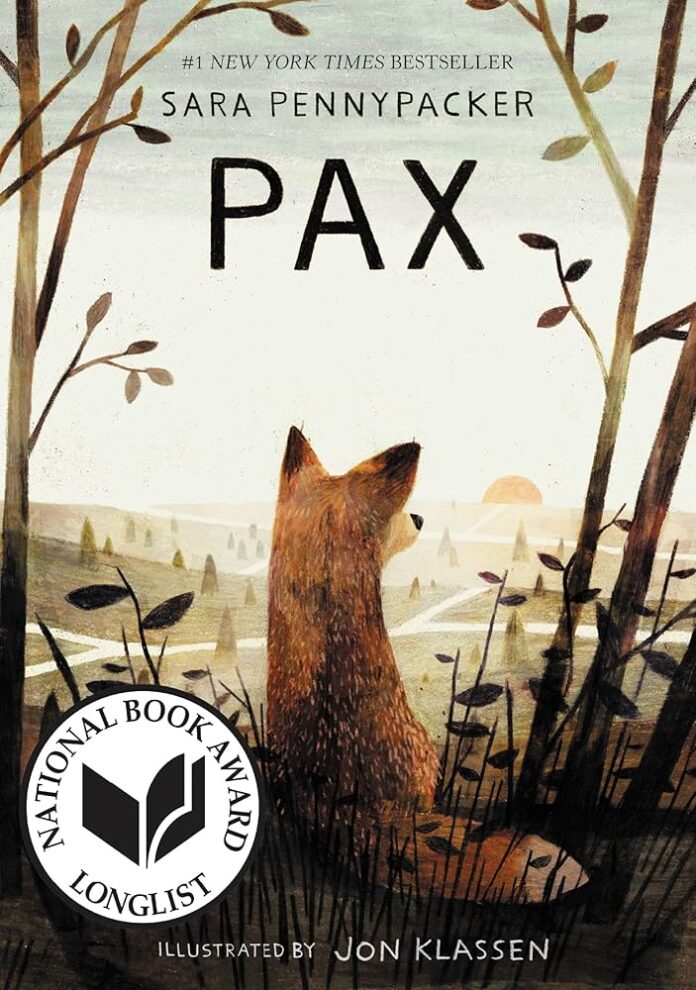In a world often punctuated by fleeting connections and quiet acts of bravery, Sara Pennypacker’s Pax emerges as a remarkable tale that gently unravels the intricate threads of friendship and courage. This novel invites readers into the tender journey of a boy and his fox, exploring themes that resonate far beyond their shared adventures.In this review, we delve into how Pax navigates the delicate balance between loyalty and independence, courage and vulnerability, offering a narrative that is as thought-provoking as it is heartfelt.
Exploring the Deep Bonds of Friendship and Loyalty Between Peter and Pax in Sara Pennypacker’s Heartfelt Tale
In Pax, Sara Pennypacker delicately weaves a narrative that delves deep into the nuances of friendship and loyalty through the relationship between Peter and his fox, Pax. Their bond transcends the typical pet-and-owner dynamic, embodying an almost symbiotic connection marked by mutual trust and understanding.As both characters navigate the challenges of separation and survival, their unwavering commitment to one another unfolds, revealing layers of emotional resilience and growth. This portrayal encourages readers to appreciate the silent promises that true friendships uphold, even in the face of adversity.
The story illuminates several key elements that define Peter and Pax’s relationship:
- Unspoken Interaction: Their connection thrives on subtle cues and shared experiences rather than words, highlighting the power of empathy.
- Trials That Test Commitment: Both face physical and emotional obstacles that challenge their loyalty, underscoring the strength of their bond.
- Growth Through Separation: Distance becomes an unexpected catalyst for deeper understanding and personal change.
| Aspect | Peter | Pax |
|---|---|---|
| Symbol of Loyalty | Relentless determination | Faithful companionship |
| Emotional Struggles | Guilt and obligation | Fear and confusion |
| growth Outcome | Self-reliance | Trust in humanity |
How Courage Manifests Through challenges and Growth in the Journey of a Young Boy and His Fox Companion
In the heart of Pax, courage is not portrayed as a grand, heroic act, but rather as a quiet, persistent force that grows as both the boy and his fox navigate the unpredictable wilderness.The young protagonist’s bravery unfolds through moments of vulnerability, where stepping beyond comfort zones becomes a testament to his resilience. This courage is intricately tied to his evolving relationship with the fox,where every challenge – from an injury to isolation – requires both to adapt and grow. The story beautifully captures how true courage involves confronting fear, embracing uncertainty, and learning from setbacks.
- Facing physical hardship: The boy’s determination to survive despite injuries symbolizes the raw grit needed to persevere.
- Nurturing patience: Both learn that courage isn’t always immediate action, but often waiting and understanding each other’s needs.
- Building trust: Risking vulnerability to form a deep bond turns fear into mutual strength.
| Challenge | Boy’s Response | Fox’s Growth |
|---|---|---|
| Separation Anxiety | Silent reflection and hope | Learning survival instincts |
| Physical Injury | Endurance and care | Adaptation to new environment |
| Wild threats | Protective alertness | Cautious exploration |
The Role of Nature as a Reflective Backdrop Enhancing Themes of Survival and Connection in Pax

In Pax, nature transcends its role as a mere setting, evolving into a living, breathing canvas that mirrors Peter’s internal journey. The sprawling forests, tranquil brooks, and rugged terrains become silent witnesses to moments of fear, hope, and resilience. Each rustling leaf and shadowy thicket not only challenges Peter’s survival skills but also deepens his bond with Pax, emphasizing a profound theme: survival is not solely about endurance but about connection-both with others and with the environment. This immersive backdrop cultivates an atmosphere where the characters’ emotional landscapes are reflected in the unpredictable rhythms of nature.
Key elements of nature’s role in Pax include:
- Symbolic landscapes: the forest represents both obstacle and sanctuary, highlighting the duality of fear and comfort.
- Interactive environment: Natural elements actively influence the narrative, from the changing seasons to the dangers that the protagonists face.
- Emotional resonance: The serenity and turmoil of the wilderness echo Peter’s evolving feelings of loneliness, courage, and hope.
| Nature Element | Symbolism | Impact on Characters |
|---|---|---|
| Dense Forest | Unknown challenges & protection | Tests Peter’s resilience, provides refuge |
| Open Fields | Freedom & vulnerability | Reflects moments of hope and exposure |
| Flowing Stream | Life’s continuity & change | Encourages reflection and adaptation |
Analyzing the Emotional Nuances that Bring Peter’s Inner Struggles to Life with Subtlety and Compassion

Peter’s emotional landscape is masterfully crafted with a depth that invites readers to walk alongside his vulnerabilities and resilience. Pennypacker doesn’t resort to melodrama; rather, she uses quiet moments and introspective pauses to reveal the shifting tides of his feelings. His inner struggles are painted with subtle shades of fear,hope,and longing,allowing us to empathize with a boy caught between the instinct to protect and the need to let go. The nuanced way his fears manifest-whether through his cautious interactions or his moments of silence-reflects a realistic portrayal of adolescence that feels both honest and tender.
To illustrate the complexity of Peter’s emotional journey, consider the following emotions and how they intertwine throughout the narrative:
- Confusion: Facing change without clear answers.
- Protectiveness: A fierce yet vulnerable desire to shield those he loves.
- Loneliness: A quiet ache that lingers beneath bravado.
- Growth: Moments of self-awareness that signal transformation.
| emotion | Manifestation | Impact on Character |
|---|---|---|
| Fear | Silent hesitation to face reality | Builds tension and empathy |
| Hope | Clinging to memories and dreams | Drives motivation and courage |
| Love | Protective actions toward Pax | Deepens character relatability |
the Art of Balancing Adventure and Tender Moments to Engage Readers Across Different Age groups

Such an approach appeals across age groups by layering the narrative experience:
- Young readers find excitement in the action-packed sequences and the loyalty between Peter and his fox.
- Older readers appreciate the subtleties of loss, resilience, and the moral dilemmas woven into the story.
- Educators and parents recognize the book’s ability to spark discussions about empathy, responsibility, and the complexities of friendship.
| Element | Adventure | Tender Moments |
|---|---|---|
| Purpose | Engage curiosity and action | Build emotional connection |
| Impact | Stimulates excitement and suspense | Fosters empathy and reflection |
| Audience | Primarily younger readers | All ages, including adults |
Symbolism and Metaphors That Deepen the Story’s message About Letting Go and Finding Strength Within

Throughout Pax, Sara Pennypacker elegantly weaves symbolism and metaphors that invite readers to explore profound themes beneath the surface narrative.The fox itself emerges as a powerful symbol of freedom and vulnerability, embodying the delicate balance between dependence and independence. Its journey mirrors the protagonist’s emotional struggle to release what he loves while discovering resilience within himself. The recurring motif of the falcon-a predator yet a representation of noble strength-adds layers to the story’s message, reminding us that courage frequently enough emerges in unexpected forms and places.
These symbols resonate further through subtle natural imagery that captures transformation and growth.Elements such as the changing seasons and the river’s flow act as metaphors for time’s passage and the healing process. For example, the river’s current reflects the inevitable push forward in life, urging release and renewal. Here’s a simple illustration of how key symbols align with thematic elements:
| Symbol | Representation | Connection to Theme |
|---|---|---|
| Fox | Innocence & freedom | Letting go & inner strength |
| Falcon | courage & Power | Bravery in vulnerability |
| River | Change & Time | Healing & moving forward |
A Close Look at the Narrative Style That Combines simple Language With Profound Emotional Impact

Sara Pennypacker’s Pax masterfully employs a narrative style that feels both accessible and deeply resonant. The prose is deliberately unadorned, allowing readers of all ages to engage with the story without getting lost in complicated language. This simplicity serves as a powerful vessel for conveying complex emotions. By choosing precise, everyday words, Pennypacker invites readers to experience the raw, unfiltered feelings of both Peter and Pax, his fox. The emotional journey feels organic, making the moments of joy, fear, and uncertainty all the more impactful as they unfold naturally within the story’s rhythm.
The narrative balance between simplicity and depth is enhanced by the subtle use of literary devices that evoke emotion without overwhelming the reader. Imagery, repetition, and pacing work in tandem to create a gentle emotional crescendo that mirrors Peter’s personal growth. Consider this breakdown of key narrative elements that contribute to the emotional impact:
| Element | Impact on Reader |
|---|---|
| Simple diction | Accessible and relatable language |
| Repetition | Emphasizes emotional themes, builds connection |
| Imagery | Creates vivid, immersive experiences |
| Pacing | Reflects Peter’s emotional evolution |
- Minimalist dialog highlights authentic interactions and vulnerability.
- Symbolism subtly threads deeper meaning without disrupting narrative flow.
- Internal monologues reveal the protagonist’s conflicting emotions, adding layers of complexity.
The Importance of Family Dynamics in Shaping Peter’s Decisions and His Personal Transformation
Peter’s journey in Pax is deeply intertwined with the subtle yet powerful currents of family influence. His decisions, often fraught with internal conflict, echo the complexities of his relationships at home.The emotional distance between Peter and his father propels him into a world of self-reliance and courage, forcing him to confront his own fears and desires without the usual safety net of parental support. This dynamic shapes not only his choices but also the very essence of his growth, illustrating how familial bonds-or their absence-can spur profound personal transformation.
Within the narrative, family dynamics function as both a catalyst and a mirror for Peter’s evolving identity.His mother’s nurturing presence contrasts sharply with his father’s stern pragmatism, creating a tension that mirrors Peter’s internal struggle between dependency and autonomy.Key influences include:
- Emotional resonance and conflict with parents
- Expectations and unspoken pressures
- The reconciliation of personal values with family legacy
| Family Member | Role in peter’s Growth | Impact on Decisions |
|---|---|---|
| father | Disciplinarian, distant | Pushes Peter toward independence |
| Mother | Supportive, caring | Provides emotional grounding |
| Sister | Absent but symbolic | Represents lost connection |
Ultimately, these familial relationships form the emotional landscape that informs how Peter navigates challenges-balancing vulnerability with bravery in his quest for identity and belonging.
How Pax Encourages Readers to Rethink Human-Animal Relationships and the Power of Empathy

Pax masterfully dismantles conventional boundaries between humans and animals, inviting readers into a world where empathy becomes a bridge rather than a barrier. Through the evolving bond between Peter and his fox, the narrative reveals how understanding and respect can transform relationships traditionally governed by dominance or fear. This shift compels readers-young and old alike-to reconsider how empathy operates not just as an abstract value, but as an actionable force that nurtures connection and healing across species. The story’s emotional depth encourages a profound reflection on coexistence, emphasizing that true courage often lies in recognizing the vulnerabilities we share with the natural world.
- Interconnectedness: Pax illustrates the symbiotic ties binding humans and animals, suggesting a shared responsibility for each other’s welfare.
- Empathy as Action: rather than passive sympathy, the characters model empathy through intentional, compassionate choices impacting both their lives.
- Reevaluating Power: The story challenges readers to question customary hierarchies, fostering respect that upends the predator-prey dynamics.
| Theme | Human-Animal Insight | Empathy Impact |
|---|---|---|
| Connection | Shared emotions shape behavior | Promotes mutual understanding |
| Vulnerability | Both species experience fear and pain | Builds compassionate responses |
| Growth | Learning from each other’s needs | Encourages patient nurturing |
Visual Imagery and Descriptions That Paint a Vivid Picture of the Rural Setting and Its Influence on the Plot

In Pax, Sara Pennypacker masterfully uses vivid visual imagery to immerse readers in the tranquil yet sometimes harsh rural landscape. Through rich descriptions of sprawling fields, whispering forests, and the changing colors of the seasons, the setting becomes almost a character itself-reflecting the emotional journey of the protagonist. for instance, when Peter treks through dense woods or sits atop grassy hills, readers can almost feel the cool breeze or hear the rustle of leaves beneath his feet. This intimate connection to the environment not only paints a breathtaking backdrop but also mirrors the themes of growth, separation, and reunion that are central to the plot.
The rural setting exerts a palpable influence on the storyline,shaping the challenges and decisions Peter faces. The isolation of the countryside underscores his struggle for independence and self-reliance, while the wildness of nature parallels the unpredictability of his relationship with Pax. Consider the following elements carefully woven into the narrative:
- Natural obstacles: Rivers, rocky terrains, and dense forests serve as symbolic hurdles that test Peter’s courage and determination.
- Seasonal shifts: Transition from the vibrant warmth of summer to the stark cold of autumn reflects the changing dynamics between boy and fox.
- Animal interactions: Encounters with wildlife highlight themes of survival and coexistence within the rural ecosystem.
| Setting Element | Symbolism | Plot Impact |
|---|---|---|
| Forest | Uncharted territory / Growth | Peter’s self-discovery and challenges |
| Open Fields | Freedom / Vulnerability | Moments of peace and danger |
| Rivers | Barriers / Transitions | Physical and emotional crossings |
themes of Forgiveness and Acceptance Woven Seamlessly Into the Character Arcs and Story Progression

In Pax, forgiveness unfolds not as a grand gesture but as a series of quiet, intimate moments that enrich the journey of both Peter and his fox, Pax. This nuanced exploration allows characters to confront their own imperfections with gentle acceptance, whether it’s Peter coming to terms with his impulsiveness or the wild fox learning to trust again. Through their intertwined paths, the story gracefully navigates the delicate terrain where apology becomes a bridge to renewed connection rather than a mere obligation.
The narrative’s strength lies in its ability to weave these emotional threads seamlessly alongside moments of growth and discovery. Consider the following elements that highlight this dynamic:
- Peter’s evolving self-awareness: Shift from stubbornness to understanding as he learns to accept circumstances beyond his control.
- Pax’s gradual adaptation: Embracing the wild while retaining memories of companionship and safety.
- Mutual healing: Both characters embody forgiveness as a process, not an endpoint, fostering patience and resilience.
| Character | initial Conflict | Resolution Approach |
|---|---|---|
| Peter | Struggles with independence and guilt | Embraces responsibility and self-forgiveness |
| Pax | Fear of abandonment | Finds trust through gradual acceptance |
Recommendations for Educators and Parents on Using Pax to Spark Conversations About Emotions and Resilience

To support this, here’s a rapid-reference guide for conversation starters and activities that pair well with the themes of Pax.These can be customized based on age and comfort level,making them versatile tools in both classroom and home settings:
| Theme | Suggested Activity / Prompt |
|---|---|
| Friendship | Draw or write about a person or pet who makes you feel safe and why. |
| Courage | Share a story when you stood up for yourself or others even if you felt scared. |
| Resilience | Create a “resilience toolkit” – list or collect items/ideas that help you bounce back. |
| Empathy | Role-play scenes to understand how characters feel in tough situations. |
Comparing Pax With Other Contemporary Middle-Grade Novels Focused on Friendship and Emotional Growth

These novels frequently enough invite readers into emotionally charged journeys where characters learn invaluable life lessons, but Pax differentiates itself through its minimalist prose and symbolic use of nature. Below is a brief comparison highlighting how Pax and its contemporaries approach key themes:
| Aspect | Pax | Wonder | Because of Winn-Dixie |
|---|---|---|---|
| Core Friendship | Human and animal bond | Peer acceptance | Human-human connection |
| Emotional Growth | Self-reliance through loss | Empathy through adversity | Healing through community |
| Writing Style | Poetic and sparse | Direct and heartfelt | Warm and anecdotal |
Ultimately, readers seeking stories about friendship enriched with emotional depth will find that Pax offers a quiet, contemplative experience that complements the more extroverted narratives of its peers. Its emphasis on silent courage and mutual respect between species adds a subtle sophistication, making it a memorable and distinct voice in the realm of middle-grade literature.
A Tribute to Sara Pennypacker’s Skillful Storytelling and Her Contribution to Contemporary Children’s Literature

Sara Pennypacker’s literary prowess shines brilliantly in Pax,a work that effortlessly captures the subtleties of friendship and the nuanced dance between fear and bravery. Her storytelling transcends mere narrative, weaving emotions into a tapestry that resonates deeply with readers of all ages.Through her vivid descriptions and authentic character development, Pennypacker creates a world where the unspoken bonds between human and animal come alive, encouraging empathy and reflection. The novel’s restrained yet powerful prose invites readers to explore themes of loss, resilience, and the complexities inherent in the journey toward independence.
Her contribution to contemporary children’s literature is marked not just by memorable stories but by her ability to challenge and expand the genre’s emotional depth. Pennypacker’s works frequently enough incorporate:
- Multi-dimensional characters whose struggles feel palpable and inspiring,
- Settings that serve as more than backdrops, acting as catalysts for growth and self-discovery,
- Thematic courage, encouraging young readers to confront difficult questions about identity and belonging.
This thoughtful approach not only elevates the reading experience but underscores her role as a pivotal figure influencing and enriching the landscape of modern children’s literature.
In unraveling the delicate threads of friendship and courage woven through sara Pennypacker’s pax, this review has sought to illuminate the quiet strength at the heart of the story. The novel invites readers to explore the complexities of bonds formed in adversity, reminding us that bravery frequently enough comes not from grand gestures, but from the small, valiant acts of understanding and loyalty. Whether you find solace in its pages or challenge its moments, Pax offers a thoughtful journey-one that lingers long after the final word, gently urging us to reconsider the true meaning of companionship and resilience.









